It’s possible to bake homemade sourdough bread without a Dutch oven, and still end up with a delicious, flavorful loaf. You can even get that signature crusty exterior and soft, airy crumb with a few tips and tricks. Don’t have a Dutch oven, but want to bake sourdough? This is for you!
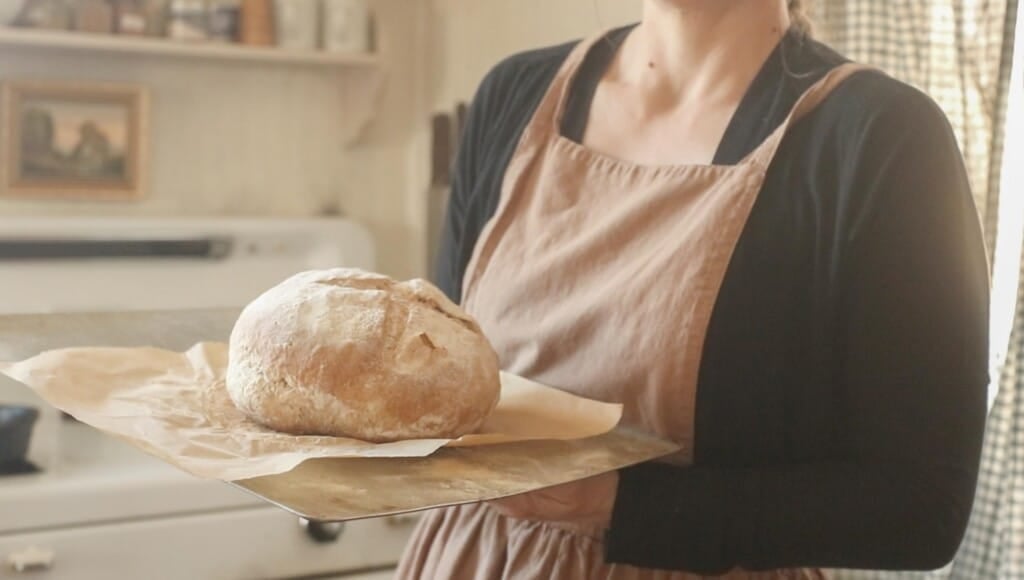
Sourdough baking can be intimidating.
There’s all those special terms – hydration, bulk fermentation, autolyse … and the list goes on.
Plus, there seems to be a plethora of tools needed to even get started. You’ll hear people talk about Banneton baskets, scoring lames, and, of course, Dutch ovens.
The good news? You don’t have to have those terms memorized or all those fancy tools in order to make beautiful loaves of sourdough.
In fact, I’ll let you in on a secret. I didn’t have many of these things when I started out.
I simply took my yeast bread recipe and converted it to sourdough. After a lot of experimenting and practice, here I am 10 years later making anything and everything with my sourdough starter.
One thing I learned through all that practice is how important your baking vessel is.
I do believe a Dutch oven will give you the best results when baking sourdough bread.
However, it is totally possible to make delicious sourdough without one. You just have to know the science behind why a Dutch oven works so well and how to emulate it.
This post contains affiliate links, which means I make a small commission at no extra cost to you. See my full disclosure here.
Why are Dutch ovens typically used to bake sourdough bread?
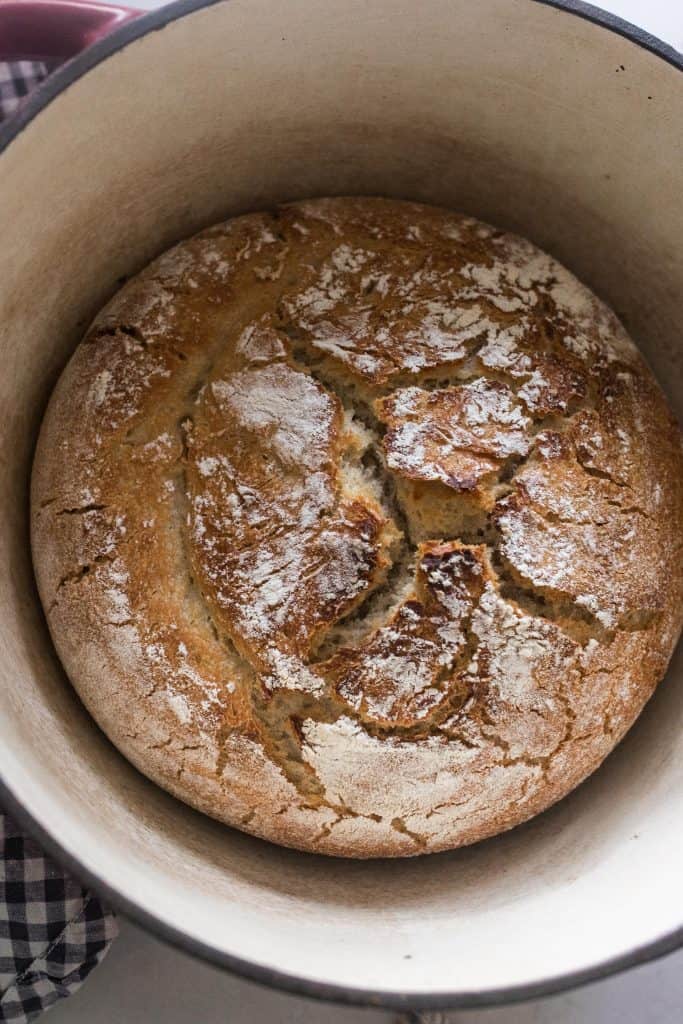
A Dutch oven is a cast iron pot with a lid. You will find a variety of sizes and types, such as regular uncoated or enamel coated.
Cast iron Dutch ovens are usually the tool of choice when baking up a loaf of crusty sourdough bread.
Here’s why:
- Cast iron holds heat really well
Cast iron holds and distributes heat well, giving you an even bake. - Cast iron can withstand the high temperatures
As you’ve probably noticed, most sourdough bread recipes require a high heat for baking. I usually bake at 500℉ with the lid on for the first part of the bake. - Thanks to the lid, a Dutch Oven is able to create steam
Steam is the key to a perfect sourdough loaf with an airy crumb and crispy crust. When the lid is on the Dutch oven, water inside the dough vaporizes, creating steam.
If you plan to make a lot of sourdough bread, I highly recommend investing in a Dutch oven like this one. They are handy to have for other things, too. One of my favorite things to make in them are soups, like my Easy Cheeseburger Soup Recipe.
You really get the best results with a Dutch oven. If you don’t have one though and are not ready to invest in one, keep reading to discover some of the best alternative methods to still make delicious sourdough bread!
The Importance of Steam
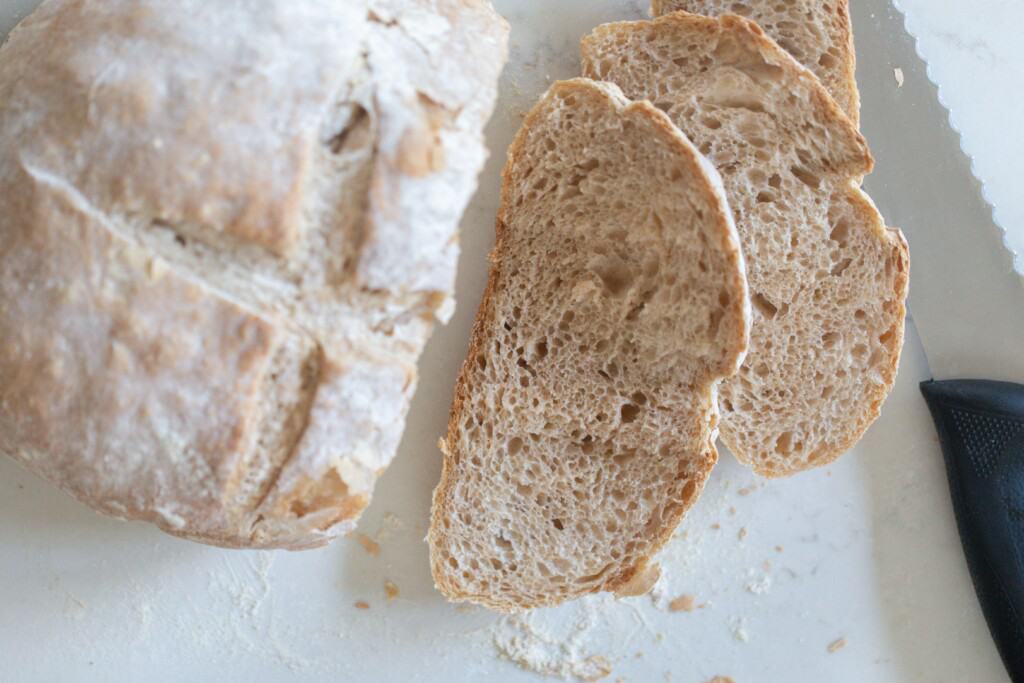
If you’ve glanced at a sourdough recipe, you probably noticed there are two phases to the bake.
Like in my classic no-knead recipe, you first bake your loaf with the lid on your Dutch oven. After 20 minutes or so, you then remove the lid and finish baking.
The lid of the Dutch oven traps in the steam created from the liquid in the bread dough. It’s the steam that gives you good oven spring and an airy crumb. Without it, the crust would harden too quickly and your bread would likely not expand to its full potential.
By taking the lid off for the second half of the bake, you end up with a golden brown crusty loaf.
Without a Dutch oven, home bakers have to create a steamy environment using other methods.
Creating Steam Without a Dutch Oven
There are a variety of ways you can create steam in your oven without a Dutch oven. It’s really your preference!
Here are a few ways you can create steam manually:
Boiling Water in Cast Iron Skillet
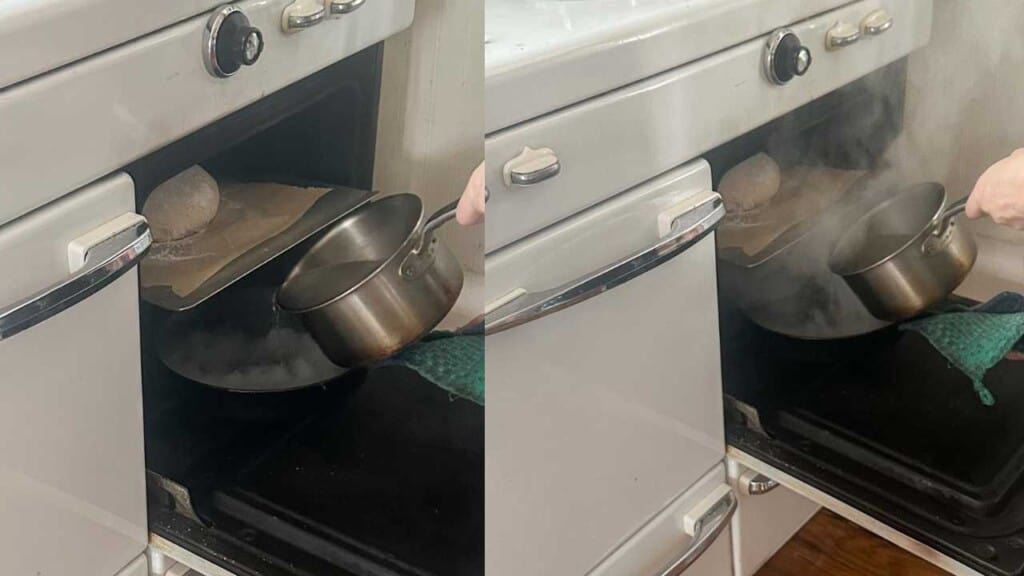
This is my method of choice. Simply preheat your cast iron skillet on the bottom rack of the oven before you add your sourdough. Place your bread, either on a baking stone or cookie sheet on the middle rack, and then pour boiling water into the skillet.
A word of caution here – you are working with a very hot oven and very hot water. Be very careful and make sure to use oven mitts that can handle the heat.
Pie Weights in a Cast Iron Skillet
Pie weights are small metal or ceramic balls that are typically used to help hold the shape of your pie dough when baking.
They also work great when trying to create steam. Put them into a cast iron skillet and place on the bottom rack of your oven while it preheats. Once you add your loaf to the middle rack, pour cold water over the pie weights.
Baking Dish with Rolled Up Towels
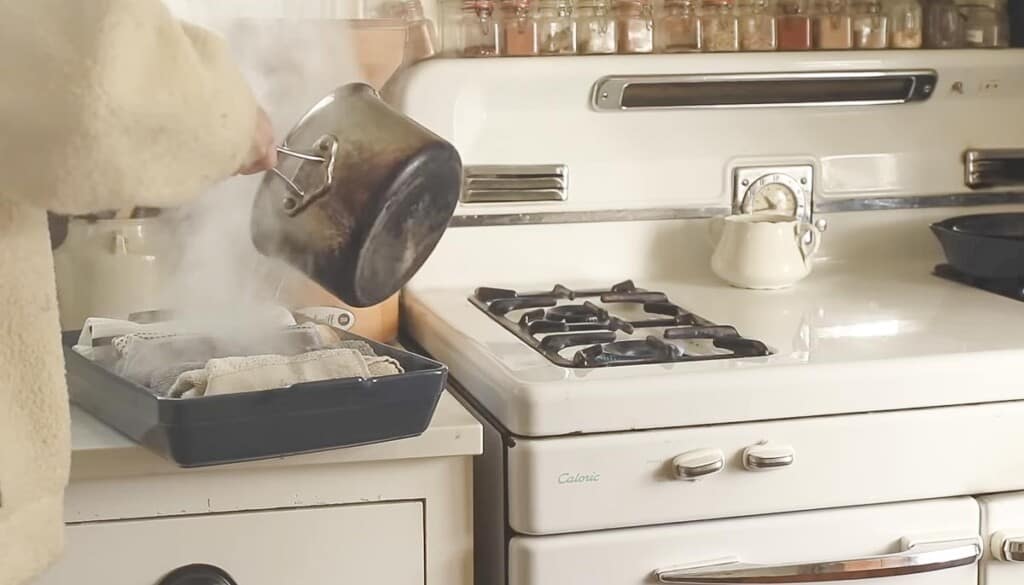
If you don’t have a cast iron skillet, you can also use a glass or oven-safe metal baking dish. It’s important to always check with the manufacturer to ensure your dish can withstand the high heat. I know some people have had their glass pans shatter in the oven.
For this method, you will roll up dish towels and place them in the pan. Pour boiling water in the dish, making sure the towels are saturated in water.
Preheat Water in a Baking Dish
Another way you can use your baking dish is simply by filling it with water and placing it in the oven during the preheat and first 15 minutes of baking.
This should be enough time for the water to create a decent amount of steam to get the desired oven rise.
You can also add ice cubes to the water once you place your bread in the oven to ensure you get enough steam. Keep in mind though that sudden extreme changes in temperature can cause pans to crack and shatter.
Spritz Water Directly Into the Oven
The simplest way to add steam is to fill a spray bottle with water and spritz the inside of your oven with it.
You can do this right when you add your bread. Make sure to do this as quickly as possible and close the oven door quickly. You want to trap that steam inside!
What You Need for an Open Bake
When baking a loaf of bread without a Dutch oven, you can use a variety of baking vessels for an open bake – as long as you create a steamy baking environment with one of the methods above.
My favorite tools to use for an open bake are a baking stone or sheet pan.
A Baking Stone
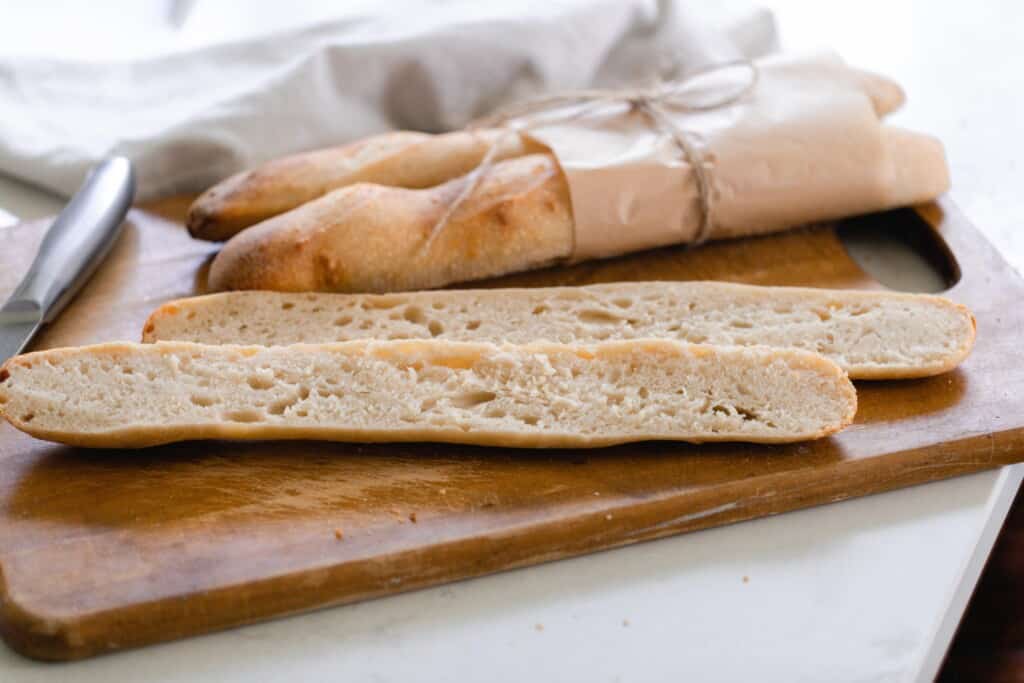
My first choice for an open bake is a baking or pizza stone. I use this method for my sourdough baguettes.
Here’s step-by-step instructions for using a baking stone:
- Preheat a baking stone for one hour on the middle rack.
- Boil water (if using this method).
- Remove dough from the fridge and score with a razor blade.
- Place a cast iron skillet on the bottom rack of the oven.
- Place the dough on a piece of parchment paper, if using, and carefully set it on the preheated baking stone.
- Carefully add the boiling water to the cast iron skillet and close the oven door.
Cookie Sheet
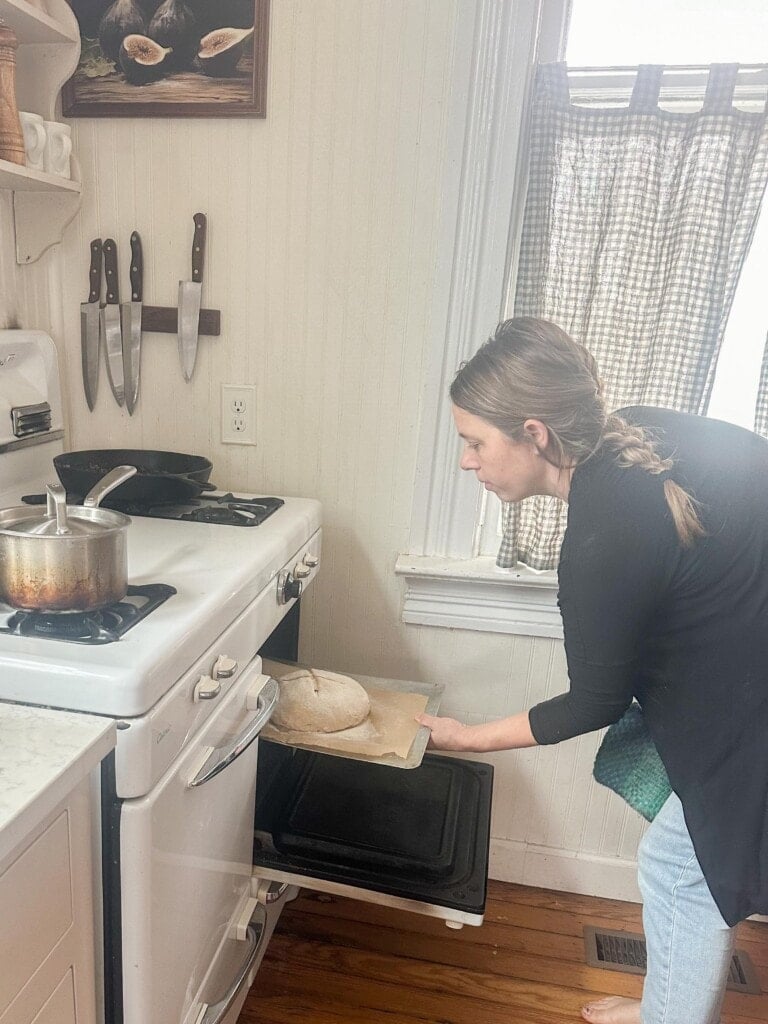
If you do not have a baking stone, a cookie sheet will also do the trick. I use this method for my sourdough bread bowls and sourdough mini loaves.
I recently experimented with this method on my regular no-knead loaf. I’ll admit, it doesn’t turn out as nice as it does with a Dutch oven, but it still creates a delicious boule!
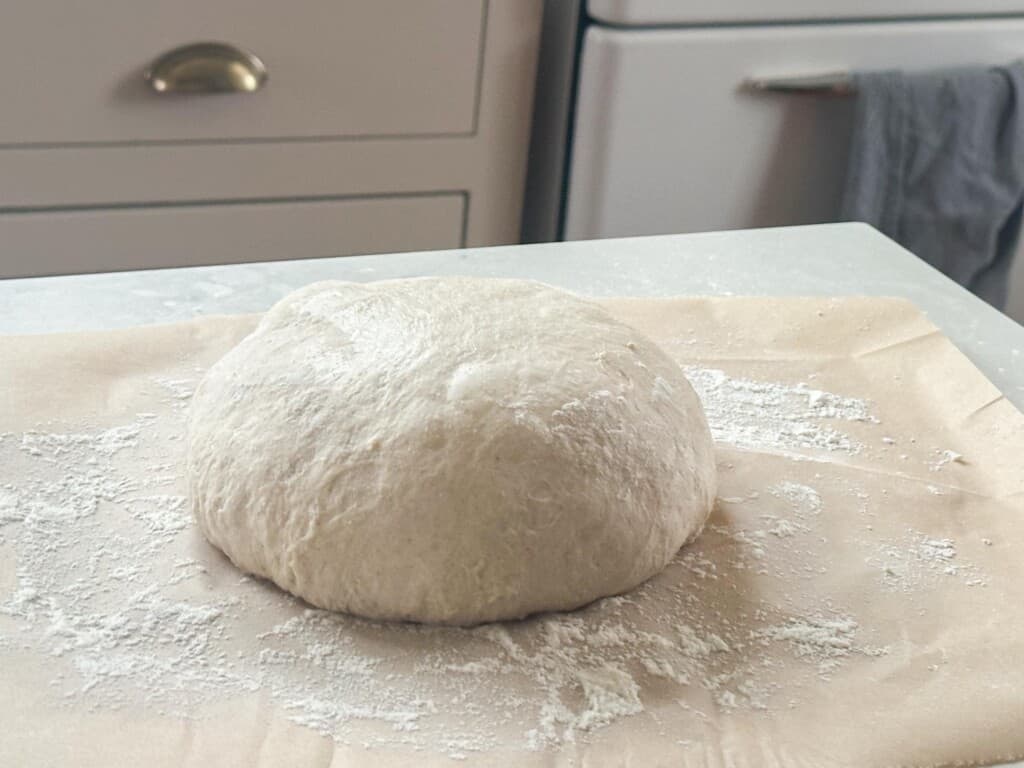
- Preheat an oven to the correct temperature.
- Once preheated, remove dough from the fridge and place on a parchment paper lined baking sheet.
- Score the loaf and place in the oven.
- Create steam using one of the methods mentioned above!
Using a Loaf Pan for Sourdough Bread
You can also bake your sourdough bread in a loaf pan.
This is a great method because you end up with even slices that are perfect for sandwiches! It also makes the shaping process a bit easier, since the pan itself will do a lot of the work for you.
To use a loaf pan, follow all the same steps through bulk fermentation. After that point, I follow very similar instructions to my sourdough sandwich bread (pictured below).
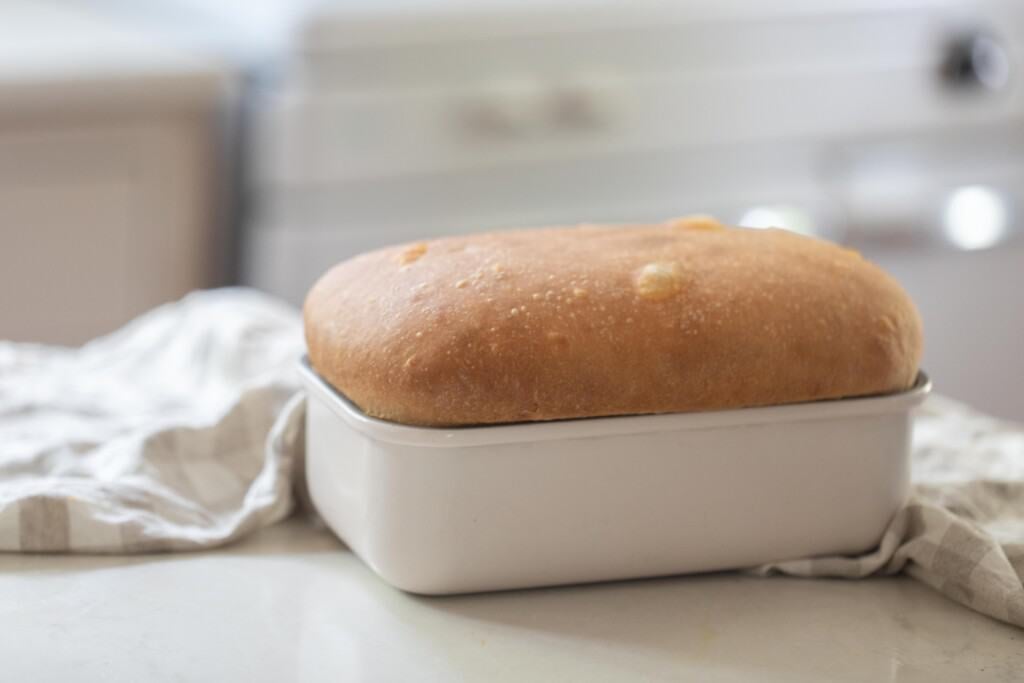
- Once the dough has fermented, shape the dough on a floured work surface by rolling it out flat into a rectangle and rolling it up. Pending how many loaves your recipe makes, you may need to divide your dough into two equal parts and shape each one separately.
- Place dough in a parchment paper lined loaf pan and put it in the fridge for the second rise.
- Bake at 375℉ for 45 minutes or until golden on top. To check if the bread is done, use a thermometer. It should be around 200 to 210 ℉.
To make your bread more like an artisan loaf, you can score the top before baking. Additionally, use any of the tips above to create more steam for better oven spring and an airy crumb.
Tips
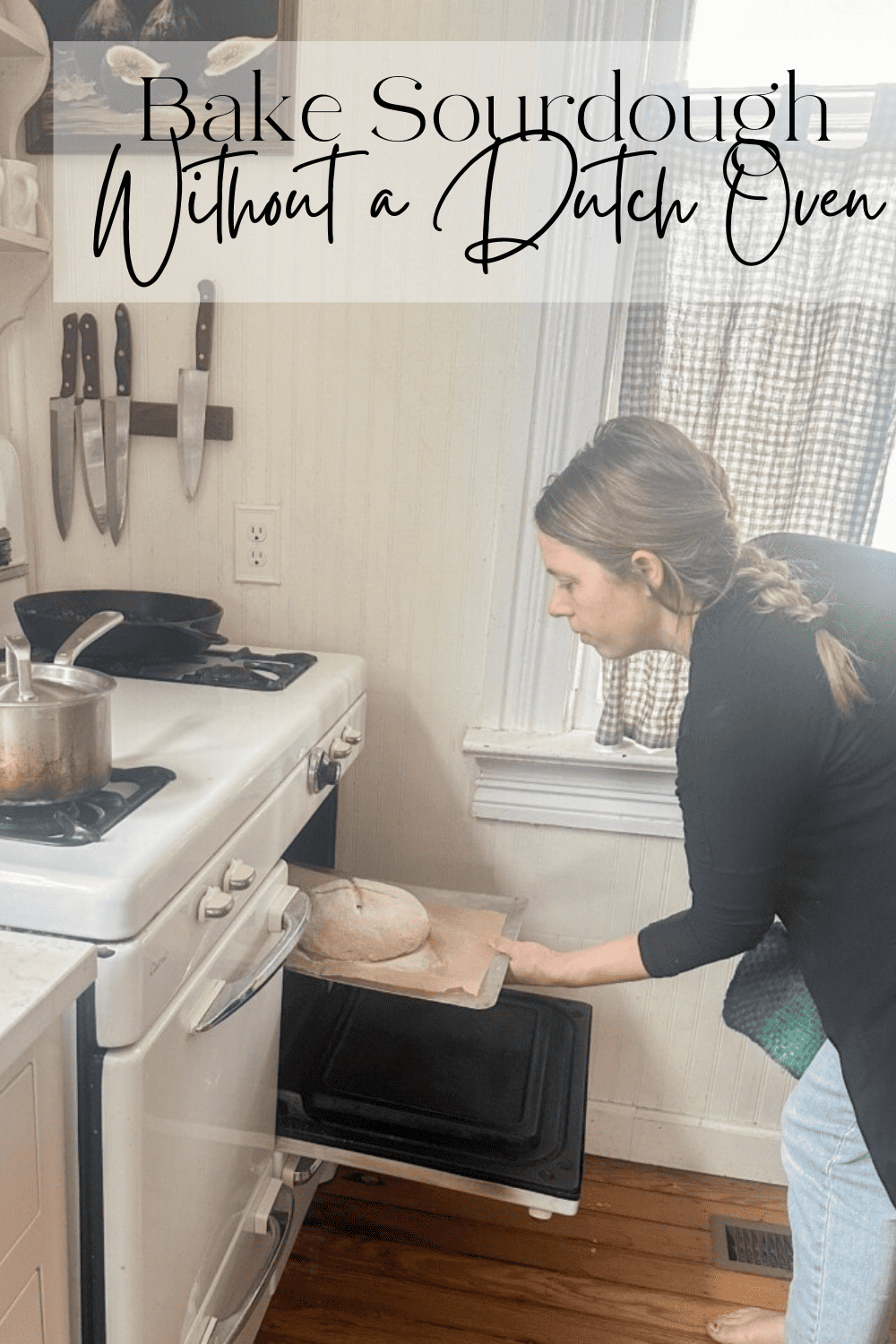
- Avoid steam burns by using oven or grilling mitts that can handle the high temperatures, like these. Most oven mitts or hot pads are not necessarily made for high heat. This is especially important when using the method of adding boiling water to your oven.
- Check with the manufacturer to make sure whatever dish you are using either to create steam or place your loaf on can withstand the high oven temperature of sourdough baking. The last thing you want is your glass to shatter. Not a fun mess to clean up!
- Spritz your dough with water when you are doing an open bake. No matter the manual steam method you choose above, spraying your dough with some water will help create extra steam for optimal oven spring.
FAQ
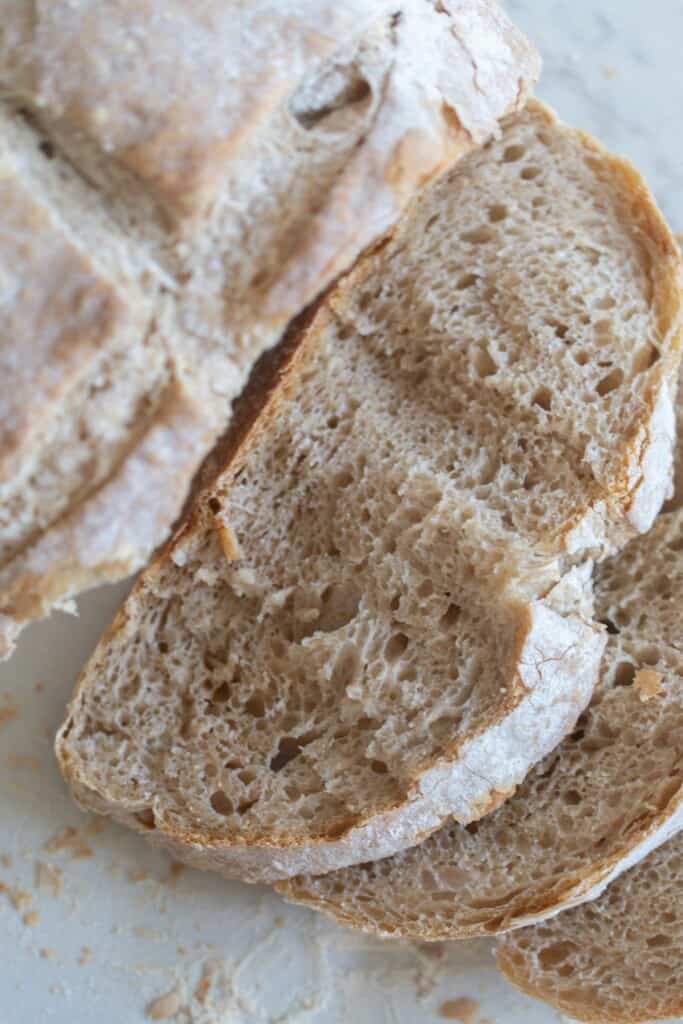
Can I use a Pyrex dish instead of a Dutch oven?
I have heard of people using Pyrex dishes to bake their bread because it has a lid to trap in steam, similar to a Dutch oven. However, according to this article, Pyrex is only oven-safe up to 425 ℉. I typically bake my sourdough bread at 500 ℉ and 475 ℉.
What is the best dish to bake sourdough in?
The ultimate dish to bake sourdough is without a doubt a Dutch oven. It traps the steam, giving you a perfect oven spring, while also holding heat and giving you a beautiful even bake.
Can I use a crockpot instead of a Dutch oven for bread?
This is another method I haven’t personally experimented with, but I know people who have with a lot of success! Again, it won’t be quite the same as sourdough baked in a Dutch oven, but it will still be delicious! The steps are all the same through the second rise. Once you score your bread, place it in your crockpot and cook on high for a couple of hours until your bread reaches around 200 – 210 ℉. Use parchment paper to keep it from sticking.
Can you bake sourdough in a cast iron skillet?
Yes! While this is not something I’ve personally tried, I know it has been done. It would be similar to the baking stone instructions above.
Can I use an enameled Dutch Oven to bake sourdough bread?
Yes! However, every brand is different, so it is important to check with the manufacturer that it can handle high heat. Lodge’s enameled Dutch ovens can go up to 500 ℉.
Other Tools For Sourdough Baking
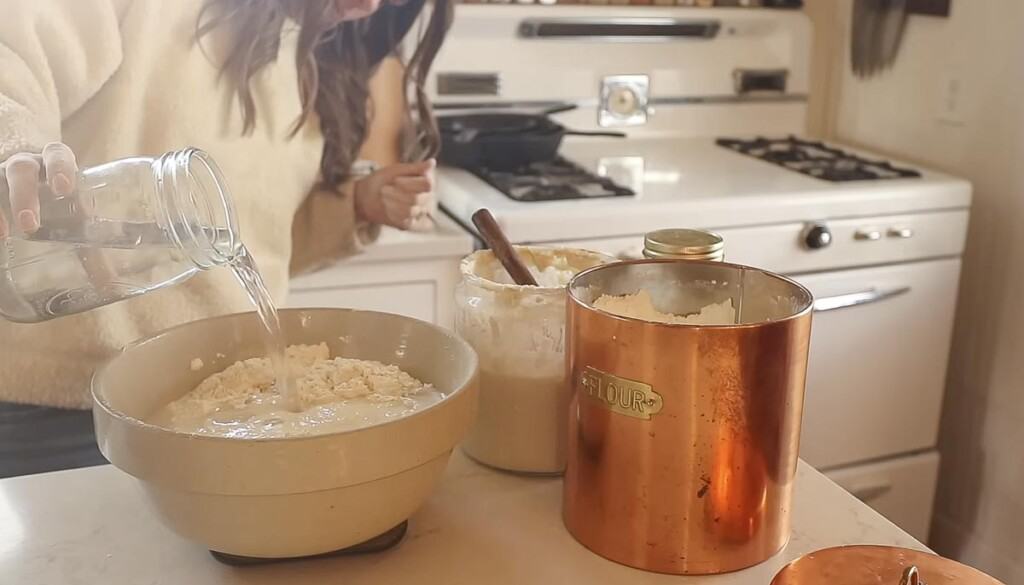
I stand by my statement – you do not need fancy supplies to be a bread baker. If you plan on making bread often, though, there are some basic tools that will come in handy. Here are a few that I like to have on hand:
Kitchen Scale – I used volume measurements for a long time with my baking. As I’ve experimented with recipes, I do find using weight measurements is really helpful, specifically for bread.
Bench Scraper – I love to use a bench scraper to divide my dough and even to help pick it up gently.
Scoring Lame – Whether you are adding beautiful patterns to your loaf or doing a simple score, a lame can be really helpful. You can also use a razor blade.
Large Bowl – I feel like every bread baker has their go-to heavy duty bowl to mix dough, complete stretch and folds, and use for bulk fermentation. Here is one of my favorites.
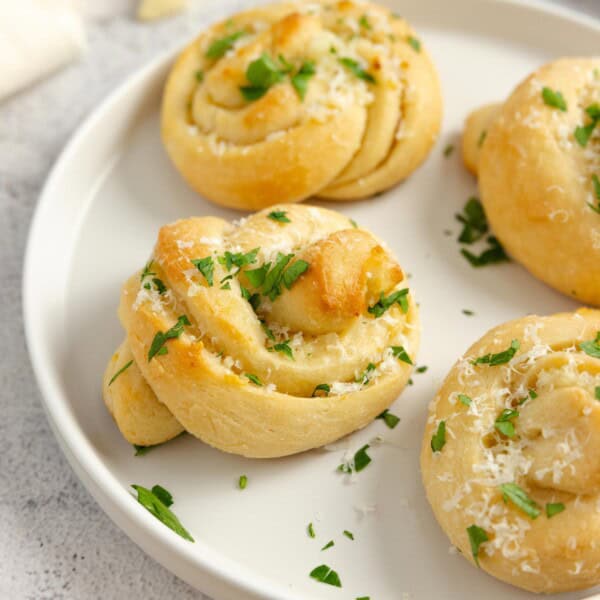
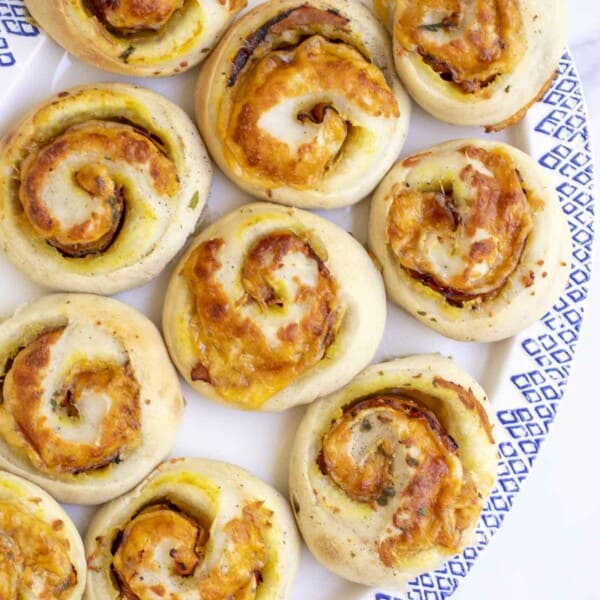








Hi! Which recipe is the bread in photo from, please?(The sliced one;) That’s exactly what I’d like to get, and I’m constantly looking for the right recipe 😆 thank you!
Here’s the link to the recipe!
I’m attempting to do an ‘open bake’ with a baking stone instead of my dutch ovens… for varying reasons. I am having a difficult time with the bottoms – they seems softer than what I prefer from the DO. I have tried directly on the stone and also with parchment paper.
Any tips on what I could be doing wrong? or how to crust up the loaf more?
You could try increasing the temperature slightly to see if that helps.
I live in a (large) 5th wheel and have a microwave/convection oven. My highest baking temperature is 400F. Do you think it will be enough?
Yes, you may just have to cook it a bit longer.
Hi, what is the loaf pan that you use for baking your sourdough bread, size and brand? Thank you! I appreciate your down to earth blog!
Here’s our loaf pans we like!
How about a baking steel instead of a baking stone? Can that work well? Thank you!
You can use a baking steel, as long as you’re providing additional steam to the oven.
Thank you! I love all breads using my sourdough starter! I have tried to convert bread recipes that use ‘active dry yeast’ with my sourdough starter. Thank you for all the recipes you provided links for and thank you for all this useful and helpful information!! I do use a dutch oven with lid and sometimes a cast iron loaf pan which i put into a baking pan with lid to create the steam.
Couldn’t see if the dutch oven is 6 or 7 quart, maybe it’s there and I missed it. Thanks Lisa for all the recipes and videos. 🙂
6 quart
Easy way to do it is to put the loaf on the baking stone and then spray it liberally with water. Place a roasting pan lid over it which covers it completely an lays totally on the baking stone. Leave on for 15 minutes of the baking time, then remove. It makes a little steam oven!
Thanks for the info! I do not have a dutch oven yet, so I’m going to try the stone with cast iron to create the steam. Does the timing change on how long I cook it? And do I take the cast iron out when I lower the temp (when you would normally remove the lid)?
The timing should stay the same! And you do not need to remove it. Good luck!
This is a great alternative! I have a Dutch oven but the heat resistance is only up to 390F. How do you recommend I bake my sourdough in my dutch oven? Is it even possible at a lower temperature?